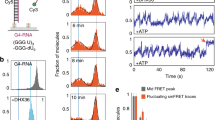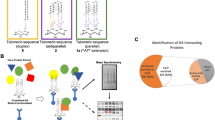Abstract
One of the main players in the cell-specific replication timing pattern is Rap1 interacting factor-1 (Rif1). Rif1 protein consists of N-terminal and C-terminal domains and an intrinsically disordered region in between. It has been suggested that both N- and C-termini of Rif1 are capable of binding to DNA with particularly high affinity to cruciform DNA structures. In the present study, we expressed, solubilized, and purified the maltose-binding protein-tagged murine Rif1 C-terminal domain (MBP-muRif1-CTD). Biological activity of the purified protein was assessed by the electrophoretic mobility shift assay (EMSA) and surface plasmon resonance (SPR). Our results show that the MBP-muRif1-CTD binds G-quadruplex (G4) structure with high affinity (KD 19.0 ± 0.8 nM), as was previously suggested. This study is the first step in investigation of the interaction of MBP-Profinity eXact-muRif1-CTD and G4 by SPR.
Graphic abstract






Similar content being viewed by others
Abbreviations
- EMSA:
-
electrophoretic mobility shift assay
- MBP:
-
maltose binding protein
- Rif1:
-
Rap1-interacting factor 1
- SPR:
-
surface plasmon resonance
References
Rhind, N., and Gilbert, D. M. (2013) DNA replication timing, Cold Spring Harb. Perspect. Biol., 5, a010132, https://doi.org/10.1101/cshperspect.a010132.
Hardy, C. F., Sussel, L., and Shore, D. (1992) A RAP1-interacting protein involved in transcriptional silencing and telomere length regulation, Genes Dev., 6, 801-814.
Kedziora, S., Gali, V. K., Wilson, R. H. C., Clark, K. R. M., Nieduszynski, C. A., et al. (2018) Rif1 acts through Protein Phosphatase 1 but independent of replication timing to suppress telomere extension in budding yeast, Nucleic Acids Res., 46, 3993-4003, https://doi.org/10.1093/nar/gky132.
Cornacchia, D., Dileep, V., Quivy, J. P., Foti, R., Tili, F., et al. (2012) Mouse Rif1 is a key regulator of the replication-timing programme in mammalian cells, EMBO J., 31, 3678-3690, https://doi.org/10.1038/emboj.2012.214.
Hayano, M., Kanoh, Y., Matsumoto, S., Renard-Guillet, C., Shirahige, K., and Masai, H. (2012) Rif1 is a global regulator of timing of replication origin firing in fission yeast, Genes Dev., 26, 137-150, https://doi.org/10.1101/gad.178491.111.
Yamazaki, S., Ishii, A., Kanoh, Y., Oda, M., Nishito, Y., and Masai, H. (2012) Rif1 regulates the replication timing domains on the human genome, EMBO J., 31, 3667-3677, https://doi.org/10.1038/emboj.2012.180.
Escribano-Diaz, C., Orthwein, A., Fradet-Turcotte, A., Xing, M., Young, J. T., et al. (2013) A cell cycle-dependent regulatory circuit composed of 53BP1-RIF1 and BRCA1-CtIP controls DNA repair pathway choice, Mol. Cell, 49, 872-883, https://doi.org/10.1016/j.molcel.2013.01.001.
Silverman, J., Takai, H., Buonomo, S. B., Eisenhaber, F., and de Lange, T. (2004) Human Rif1, ortholog of a yeast telomeric protein, is regulated by ATM and 53BP1 and functions in the S-phase checkpoint, Genes Dev., 18, 2108-2119, https://doi.org/10.1101/gad.1216004.
Xu, D., Muniandy, P., Leo, E., Yin, J., Thangavel, S., et al. (2010) Rif1 provides a new DNA-binding interface for the Bloom syndrome complex to maintain normal replication, EMBO J., 29, 3140-3155, https://doi.org/10.1038/emboj.2010.186.
Sreesankar, E., Senthilkumar, R., Bharathi, V., Mishra, R. K., and Mishra, K. (2012) Functional diversification of yeast telomere associated protein, Rif1, in higher eukaryotes, BMC Genomics, 13, 255, https://doi.org/10.1186/1471-2164-13-255.
Sukackaite, R., Jensen, M. R., Mas, P. J., Blackledge, M., Buonomo, S. B., and Hart, D. J. (2014) Structural and biophysical characterization of murine rif1 C-terminus reveals high specificity for DNA cruciform structures, J. Biol. Chem., 289, 13903-13911, https://doi.org/10.1074/jbc.M114.557843.
Kanoh, Y., Matsumoto, S., Fukatsu, R., Kakusho, N., Kono, N., et al. (2015) Rif1 binds to G quadruplexes and suppresses replication over long distances, Nat. Struct. Mol. Biol., 22, 889-897, https://doi.org/10.1038/nsmb.3102.
Moriyama, K., Yoshizawa-Sugata, N., and Masai, H. (2018) Oligomer formation and G-quadruplex binding by purified murine Rif1 protein, a key organizer of higher-order chromatin architecture, J. Biol. Chem., 293, 3607-3624, https://doi.org/10.1074/jbc.RA117.000446.
Kobayashi, S., Fukatsu, R., Kanoh, Y., Kakusho, N., Matsumoto, S., et al. (2019) Both a unique motif at the C-terminus and an N-terminal HEAT repeat contribute to G-quadruplex binding and origin regulation by the Rif1 protein, Mol. Cell. Biol., 39, https://doi.org/10.1128/MCB.00364-18.
Masai, H., Fukatsu, R., Kakusho, N., Kanoh, Y., Moriyama, K., et al. (2019) Rif1 promotes association of G-quadruplex (G4) by its specific G4 binding and oligomerization activities, Sci. Rep., 9, 8618, https://doi.org/10.1038/s41598-019-44736-9.
Wang, H., Zhao, A., Chen, L., Zhong, X., Liao, J., et al. (2009) Human RIF1 encodes an anti-apoptotic factor required for DNA repair, Carcinogenesis, 30, 1314-1319, https://doi.org/10.1093/carcin/bgp136.
Mei, Y., Peng, C., Liu, Y. B., Wang, J., and Zhou, H. H. (2017) Silencing RIF1 decreases cell growth, migration and increases cisplatin sensitivity of human cervical cancer cells, Oncotarget, 8, 107044-107051, https://doi.org/10.18632/oncotarget.22315.
Liu, Y. B., Mei, Y., Long, J., Zhang, Y., Hu, D. L., and Zhou, H. H. (2018) RIF1 promotes human epithelial ovarian cancer growth and progression via activating human telomerase reverse transcriptase expression, J. Exp. Clin. Cancer Res., 37, 182, https://doi.org/10.1186/s13046-018-0854-8.
Mariani, S., and Minunni, M. (2014) Surface plasmon resonance applications in clinical analysis, Anal. Bioanal. Chem., 406, 2303-2323, https://doi.org/10.1007/s00216-014-7647-5.
Nguyen, H. H., Park, J., Kang, S., and Kim, M. (2015) Surface plasmon resonance: a versatile technique for biosensor applications, Sensors (Basel), 15, 10481-10510, https://doi.org/10.3390/s150510481.
Laemmli, U. K. (1970) Cleavage of structural proteins during the assembly of the head of bacteriophage T4, Nature, 227, 680-685.
Gabelica, V., Maeda, R., Fujimoto, T., Yaku, H., Murashima, T., et al. (2013) Multiple and cooperative binding of fluorescence light-up probe thioflavin T with human telomere DNA G-quadruplex, Biochemistry, 52, 5620-5628, https://doi.org/10.1021/bi4006072.
Renaud de la Faverie, A., Guedin, A., Bedrat, A., Yatsunyk, L. A., and Mergny, J. L. (2014) Thioflavin T as a fluorescence light-up probe for G4 formation, Nucleic Acids Res., 42, e65, https://doi.org/10.1093/nar/gku111.
Carvalho, J., Queiroz, J. A., and Cruz, C. (2017) Circular dichroism of G-quadruplex: a laboratory experiment for the study of topology and ligand binding, J. Chem. Educ., 94, 1547-1551, https://doi.org/10.1021/acs.jchemed.7b00160.
Acknowledgments
The authors are grateful to Prof. Masai and Dr. Kenji from the Tokyo Metropolitan Institute of Medical Science, Japan, for sharing their pearls of wisdom during the research and their generous contribution of different muRif1 constructs and their assistance in executing the EMSA assay in this study.
Funding
This work was financially supported by the research core of the Tarbiat Modares University, Iran (grant no. IG-39707).
Author information
Authors and Affiliations
Corresponding author
Ethics declarations
The authors declare no conflict of interest in financial or any other sphere. This article does not contain descriptions of studies with human participants or animals performed by any of the authors.
Electronic supplementary material
Rights and permissions
About this article
Cite this article
Ghadiri, H., Alavi, S., Dabirmanesh, B. et al. Characterization of Interaction of the MBP-Tagged MuRif1-C-Terminal Domain with G-Quadruplex DNA by SPR. Biochemistry Moscow 86, 898–905 (2021). https://doi.org/10.1134/S0006297921070105
Received:
Revised:
Accepted:
Published:
Issue Date:
DOI: https://doi.org/10.1134/S0006297921070105




